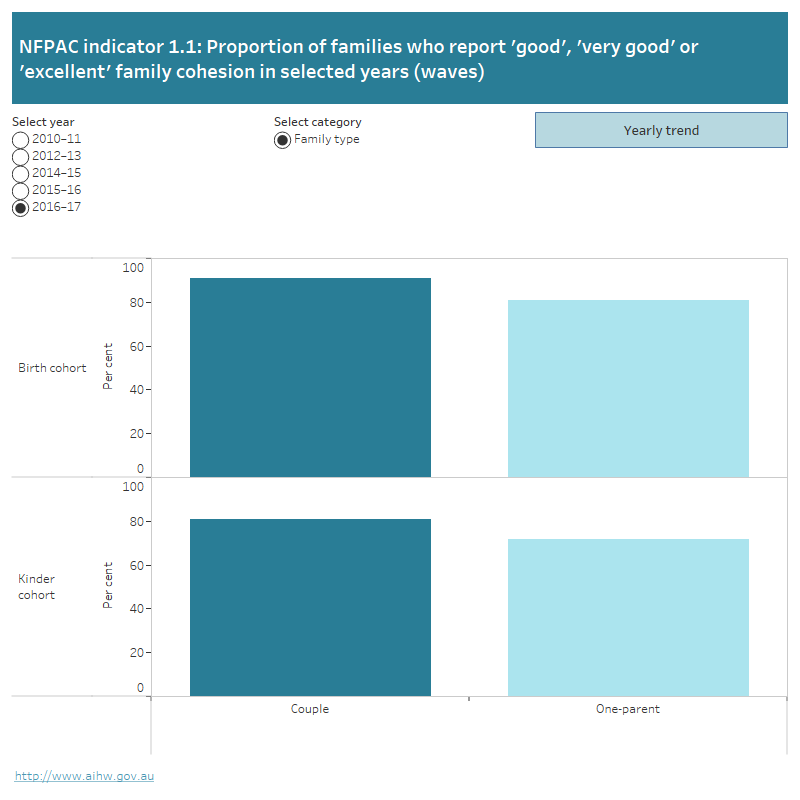1.1 Family functioning
Family functioning relates to a family's ability to interact, communicate, make decisions, solve problems and maintain relationships with each other. There are currently no national data available on a single overarching measure of family functioning. However, national data are available on family cohesion, a component of family functioning, which captures the ability of the family to get along with one another (DSS 2014).
Growing Up in Australia: The Longitudinal Study of Australian Children (LSAC) is a major study conducted in partnership between the Department of Social Services, the Australian Institute of Family Studies and the Australian Bureau of Statistics. The study measures family cohesion among families of two age-based cohorts of children: a 'birth' cohort and a 'kinder' cohort. As such, the same families are captured at each wave as the children grow older. In 2010–11 (Wave 4) the birth cohort was aged 6 to 7 years and the kindergarten cohort were aged 10 to 11 years. In the most recent year of data reported (2016–17), the birth cohort was aged 14 to 15 years and the kindergarten cohort was aged 18 to 19 years. Additional age years for the study waves are provided in the associated supplementary data table.
Trend data: For all indicator displays, the yearly trend is limited to indicators with 3 or more years (including the current year) of comparable time series data. To see the trend click on “Yearly Trend” button on the display. Where 3 or more years of comparable data including the most recent year is not available, a “No time series data” message is shown on the display.
The first figure is a bar graph showing the proportion of families who report ‘good’, ‘very good’ or ‘excellent’ family cohesion, by cohort (birth or kinder) and family type (couple or one-parent). Data can be selected by year from 2010–11 to 2016–17.
The second figure is a line graph showing the proportion of families who report ‘good’, ‘very good’ or ‘excellent’ family cohesion from 2010–11 to 2016–17 by cohort (birth or kinder) and family type (one-parent or couple).

Source: AIHW analysis of Growing Up in Australia: The Longitudinal Study of Australian
See the supplementary data tables for further information and footnotes about these data.
References
DSS (Department of Social Services) (2014) A safe and supportive family environment for children: key components and links to child outcomes, DSS, Australian Government.
Indicator technical specifications
The information below provides technical specifications for the summary indicator data presented in the quick reference guide.
| Definition | Data source | |
|---|---|---|
| Numerator |
Number of families with children in the reference period who report good, very good or excellent family cohesion |
Longitudinal Study of Australian Children (LSAC) |
| Denominator | Number of families with children in the reference period |
Longitudinal Study of Australian Children (LSAC) |
Explanatory notes
Family functioning is not easily measured and lacks easily defined concepts. Family cohesion reflects the ability of the family to get along with each other–it only partially captures the concept of family functioning, but national data are available.
The cohort nature of the LSAC limits the usefulness of the data as an indicator over time. LSAC is a longitudinal study of two age-based cohorts (i.e. children aged either 0–1 or 4–5 at wave 1), rather than a longitudinal panel study sampling a cross-section of the population. LSAC is therefore capturing the same families at each wave as the children grow older, rather than providing a more representative cross-section of the population over time. LSAC is a child-based collection, and as such, families with no children are excluded.
Family cohesion data are collected for both LSAC cohorts–the birth cohort (children aged 0–1 years at wave 1) and the child cohort (children aged 4–5 years at wave 1). As such, the reportable age groups will vary across each wave of family cohesion data as the children grow older. Each wave is two years apart.
LSAC captures parent self-reported family cohesion. Parents rate their family's ability to get along with each other against five response categories: excellent, very good, good, fair, and poor.


